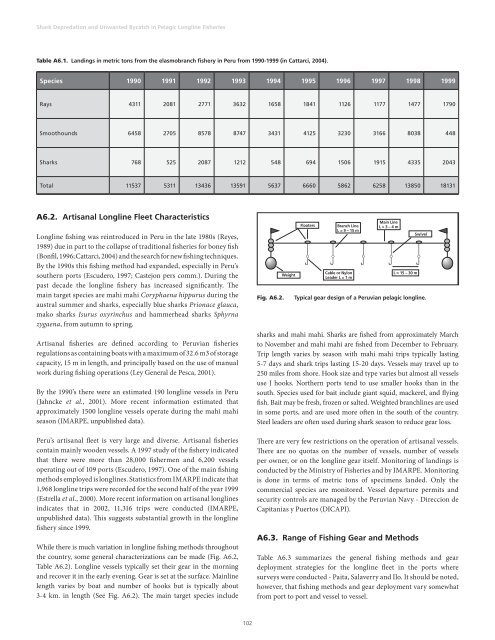Shark Depredation and Unwanted Bycatch in Pelagic Longline
Shark Depredation and Unwanted Bycatch in Pelagic Longline
Shark Depredation and Unwanted Bycatch in Pelagic Longline
Create successful ePaper yourself
Turn your PDF publications into a flip-book with our unique Google optimized e-Paper software.
<strong>Shark</strong> <strong>Depredation</strong> <strong>and</strong> <strong>Unwanted</strong> <strong>Bycatch</strong> <strong>in</strong> <strong>Pelagic</strong> Longl<strong>in</strong>e Fisheries<br />
Table A6.1. L<strong>and</strong><strong>in</strong>gs <strong>in</strong> metric tons from the elasmobranch fishery <strong>in</strong> Peru from 1990-1999 (<strong>in</strong> Cattarci, 2004).<br />
Species 1990 1991 1992 1993 1994 1995 1996 1997 1998 1999<br />
Rays 4311 2081 2771 3632 1658 1841 1126 1177 1477 1790<br />
Smoothounds 6458 2705 8578 8747 3431 4125 3230 3166 8038 448<br />
<strong>Shark</strong>s 768 525 2087 1212 548 694 1506 1915 4335 2043<br />
Total 11537 5311 13436 13591 5637 6660 5862 6258 13850 18131<br />
A6.2. Artisanal Longl<strong>in</strong>e Fleet Characteristics<br />
Longl<strong>in</strong>e fish<strong>in</strong>g was re<strong>in</strong>troduced <strong>in</strong> Peru <strong>in</strong> the late 1980s (Reyes,<br />
1989) due <strong>in</strong> part to the collapse of traditional fisheries for boney fish<br />
(Bonfil, 1996; Cattarci, 2004) <strong>and</strong> the search for new fish<strong>in</strong>g techniques.<br />
By the 1990s this fish<strong>in</strong>g method had exp<strong>and</strong>ed, especially <strong>in</strong> Peru’s<br />
southern ports (Escudero, 1997; Castejon pers comm.). Dur<strong>in</strong>g the<br />
past decade the longl<strong>in</strong>e fishery has <strong>in</strong>creased significantly. The<br />
ma<strong>in</strong> target species are mahi mahi Coryphaena hippurus dur<strong>in</strong>g the<br />
austral summer <strong>and</strong> sharks, especially blue sharks Prionace glauca,<br />
mako sharks Isurus oxyr<strong>in</strong>chus <strong>and</strong> hammerhead sharks Sphyrna<br />
zygaena, from autumn to spr<strong>in</strong>g.<br />
Artisanal fisheries are def<strong>in</strong>ed accord<strong>in</strong>g to Peruvian fisheries<br />
regulations as conta<strong>in</strong><strong>in</strong>g boats with a maximum of 32.6 m3 of storage<br />
capacity, 15 m <strong>in</strong> length, <strong>and</strong> pr<strong>in</strong>cipally based on the use of manual<br />
work dur<strong>in</strong>g fish<strong>in</strong>g operations (Ley General de Pesca, 2001).<br />
By the 1990’s there were an estimated 190 longl<strong>in</strong>e vessels <strong>in</strong> Peru<br />
(Jahncke et al., 2001). More recent <strong>in</strong>formation estimated that<br />
approximately 1500 longl<strong>in</strong>e vessels operate dur<strong>in</strong>g the mahi mahi<br />
season (IMARPE, unpublished data).<br />
Peru’s artisanal fleet is very large <strong>and</strong> diverse. Artisanal fisheries<br />
conta<strong>in</strong> ma<strong>in</strong>ly wooden vessels. A 1997 study of the fishery <strong>in</strong>dicated<br />
that there were more than 28,000 fishermen <strong>and</strong> 6,200 vessels<br />
operat<strong>in</strong>g out of 109 ports (Escudero, 1997). One of the ma<strong>in</strong> fish<strong>in</strong>g<br />
methods employed is longl<strong>in</strong>es. Statistics from IMARPE <strong>in</strong>dicate that<br />
1,968 longl<strong>in</strong>e trips were recorded for the second half of the year 1999<br />
(Estrella et al., 2000). More recent <strong>in</strong>formation on artisanal longl<strong>in</strong>es<br />
<strong>in</strong>dicates that <strong>in</strong> 2002, 11,316 trips were conducted (IMARPE,<br />
unpublished data). This suggests substantial growth <strong>in</strong> the longl<strong>in</strong>e<br />
fishery s<strong>in</strong>ce 1999.<br />
While there is much variation <strong>in</strong> longl<strong>in</strong>e fish<strong>in</strong>g methods throughout<br />
the country, some general characterizations can be made (Fig. A6.2,<br />
Table A6.2). Longl<strong>in</strong>e vessels typically set their gear <strong>in</strong> the morn<strong>in</strong>g<br />
<strong>and</strong> recover it <strong>in</strong> the early even<strong>in</strong>g. Gear is set at the surface. Ma<strong>in</strong>l<strong>in</strong>e<br />
length varies by boat <strong>and</strong> number of hooks but is typically about<br />
3-4 km. <strong>in</strong> length (See Fig. A6.2). The ma<strong>in</strong> target species <strong>in</strong>clude<br />
Fig. A6.2.<br />
Typical gear design of a Peruvian pelagic longl<strong>in</strong>e.<br />
sharks <strong>and</strong> mahi mahi. <strong>Shark</strong>s are fished from approximately March<br />
to November <strong>and</strong> mahi mahi are fished from December to February.<br />
Trip length varies by season with mahi mahi trips typically last<strong>in</strong>g<br />
5-7 days <strong>and</strong> shark trips last<strong>in</strong>g 15-20 days. Vessels may travel up to<br />
250 miles from shore. Hook size <strong>and</strong> type varies but almost all vessels<br />
use J hooks. Northern ports tend to use smaller hooks than <strong>in</strong> the<br />
south. Species used for bait <strong>in</strong>clude giant squid, mackerel, <strong>and</strong> fly<strong>in</strong>g<br />
fish. Bait may be fresh, frozen or salted. Weighted branchl<strong>in</strong>es are used<br />
<strong>in</strong> some ports, <strong>and</strong> are used more often <strong>in</strong> the south of the country.<br />
Steel leaders are often used dur<strong>in</strong>g shark season to reduce gear loss.<br />
There are very few restrictions on the operation of artisanal vessels.<br />
There are no quotas on the number of vessels, number of vessels<br />
per owner, or on the longl<strong>in</strong>e gear itself. Monitor<strong>in</strong>g of l<strong>and</strong><strong>in</strong>gs is<br />
conducted by the M<strong>in</strong>istry of Fisheries <strong>and</strong> by IMARPE. Monitor<strong>in</strong>g<br />
is done <strong>in</strong> terms of metric tons of specimens l<strong>and</strong>ed. Only the<br />
commercial species are monitored. Vessel departure permits <strong>and</strong><br />
security controls are managed by the Peruvian Navy - Direccion de<br />
Capitanias y Puertos (DICAPI).<br />
A6.3. Range of Fish<strong>in</strong>g Gear <strong>and</strong> Methods<br />
Table A6.3 summarizes the general fish<strong>in</strong>g methods <strong>and</strong> gear<br />
deployment strategies for the longl<strong>in</strong>e fleet <strong>in</strong> the ports where<br />
surveys were conducted - Paita, Salaverry <strong>and</strong> Ilo. It should be noted,<br />
however, that fish<strong>in</strong>g methods <strong>and</strong> gear deployment vary somewhat<br />
from port to port <strong>and</strong> vessel to vessel.<br />
102












